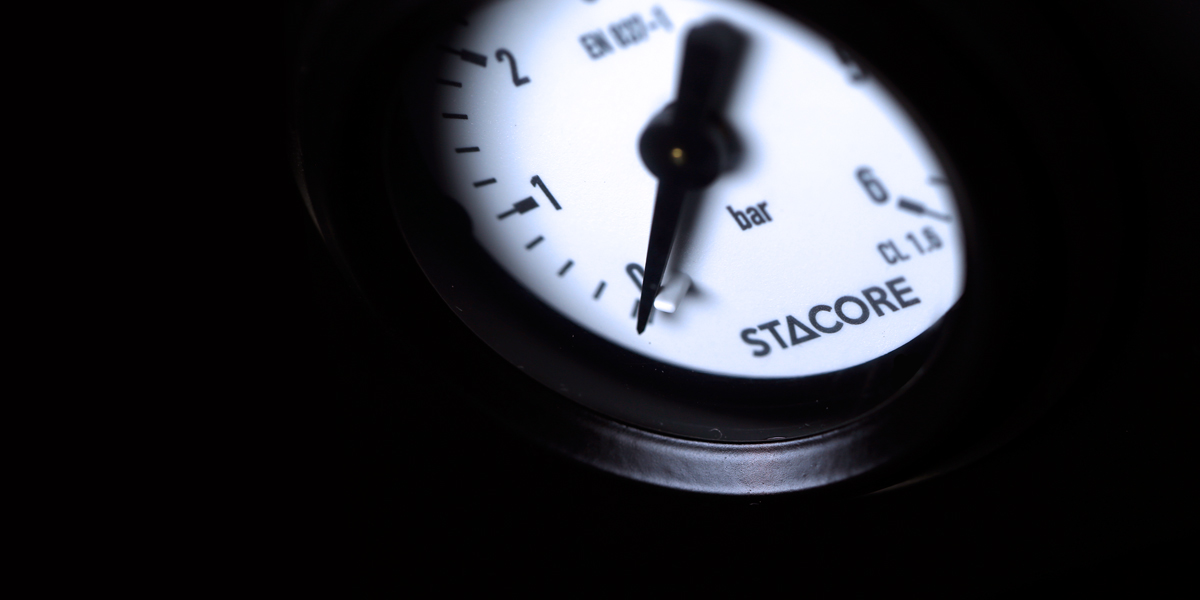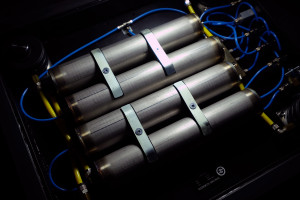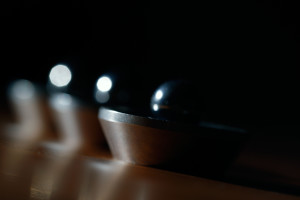Spine shattering mass, Italian amorphous slate and air pressurized lifts might not seem to be related to our hobby too tightly. But according to the local Stacore team, all this served in one package is what it takes to extract the very best out of an enthusiast’s audio hardware. To find out if that’s the case, Stacore Advanced pneumatic platform became this review’s main dish. Enjoy.
Introduction
The audio hobby is quite simple and straightforward early on, though can escalate very quickly. What starts innocently, i.e. as a pair of affordable bookshelf speakers and a similarly priced integrated amp/DAC combo, can morph into a very expensive ride based on fully separate hardware. To improve/change sound via different measures is one of the major goals of this game and – as many thrive on sheer thrill of the hunt – this can go on and on to have no end. At times to swap any of already owned audio devices can be very costly to become simply out of reach, yet the urge to push things further remains. Then to backtrack a bit and focus on aspects thus far neglected/omitted/still left to tackle sounds like a solid plan. This is where tweaks such as vibration control, room acoustics, clean power and cables step in.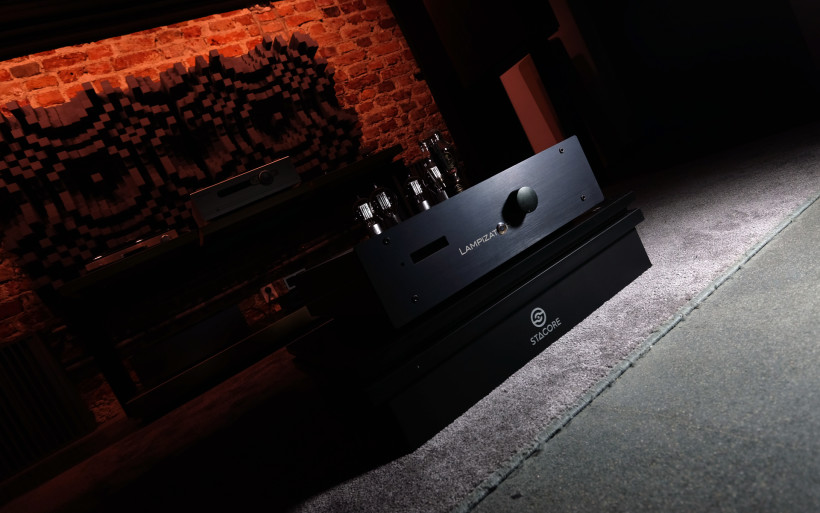 Widely considered as not canonical enough and very much snake oil alike, some of the above mentioned additions remain outside of a scope of many until proven via hard evidence to be beneficial if working at all. Not every audio product does what it’s supposed to, hence skepticism in audio is no crime, common sense tells us to be cautious and that’s perfectly fine. But there’s a substantial difference in how products are backed by their makers, especially those from the non-mainstream realm, which brings us to this review’s hero – Polish Stacore Advanced pneumatic platform. During Munich’s High End event in 2017, the Stacore team did a very scientific thus convincing job in showcasing their machine in action, please take a look here. This experience piqued my interest, thus served as an incentive to investigate further and this material is the outcome.
Widely considered as not canonical enough and very much snake oil alike, some of the above mentioned additions remain outside of a scope of many until proven via hard evidence to be beneficial if working at all. Not every audio product does what it’s supposed to, hence skepticism in audio is no crime, common sense tells us to be cautious and that’s perfectly fine. But there’s a substantial difference in how products are backed by their makers, especially those from the non-mainstream realm, which brings us to this review’s hero – Polish Stacore Advanced pneumatic platform. During Munich’s High End event in 2017, the Stacore team did a very scientific thus convincing job in showcasing their machine in action, please take a look here. This experience piqued my interest, thus served as an incentive to investigate further and this material is the outcome.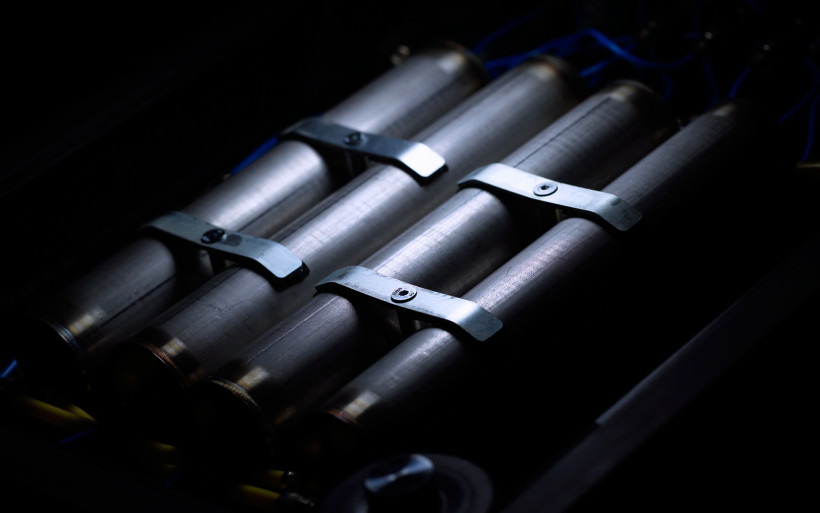 Polish Stacore operation was born not too long ago as a result of a very specific need one keen enthusiast had. Jarosław Korbicz enjoyed his turntable based rig very much, though the floor in his new flat turned out wobbly enough to become a serious issue. As a theoretical physicist with PhD and an assistant professor in CFT PAN (Center for Theoretical Physics of Polish Academy of Sciences), Jarek conducted a scientific investigation in the tweaks domain, which led him to vibration control via pneumatic suspension + high mass. Once a general idea of such a platform was ready, a hunt for someone capable of handling the manufacturing process followed shortly after. That’s how our man met Bogdan Stasiak, the other half of the Stacore duo.
Polish Stacore operation was born not too long ago as a result of a very specific need one keen enthusiast had. Jarosław Korbicz enjoyed his turntable based rig very much, though the floor in his new flat turned out wobbly enough to become a serious issue. As a theoretical physicist with PhD and an assistant professor in CFT PAN (Center for Theoretical Physics of Polish Academy of Sciences), Jarek conducted a scientific investigation in the tweaks domain, which led him to vibration control via pneumatic suspension + high mass. Once a general idea of such a platform was ready, a hunt for someone capable of handling the manufacturing process followed shortly after. That’s how our man met Bogdan Stasiak, the other half of the Stacore duo.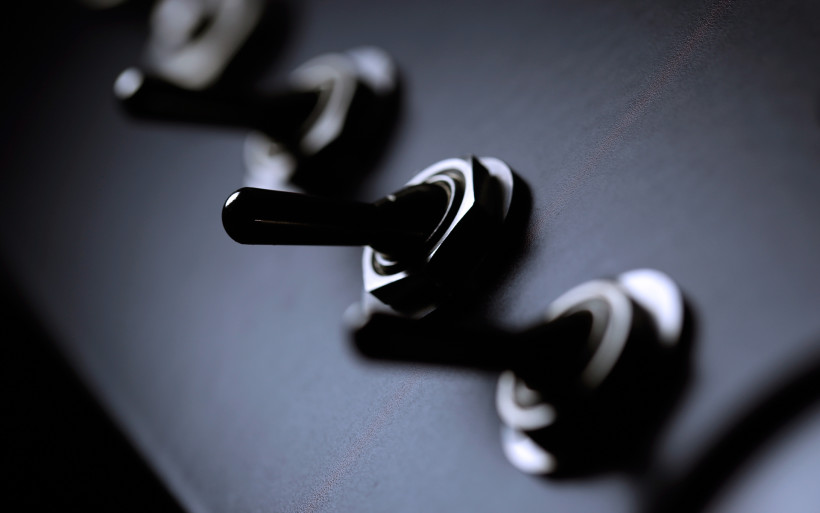 Bogdan is the owner of a well equipped machine shop ready for Stacore related production, works with naval industry and his knowledge about various materials is extensive. It’s safe to say that both gents’ skills and know-how don’t overlap but work in a very synergistic fashion instead. Bogdan has made the very first platform according to Jarek’s design and personal use specifically. This 500+ kilograms heavy beast worked like a charm with his turntable, hence the team legalized this cooperation, moved from there with more domestic line-up and this review’s hero is the outcome. For now Stacore is the side activity for both men, though current growth speed might quickly morph it into a full scale operation. And if you wonder about this company’s name, it’s a clever merger of words ‘stability’ and ‘core’, though phonetically ‘STAsiak’ and ‘KORbicz’ combo also fits. It’s also good to know that our Polish team currently also works on their Stacore Rack System. This is something to look forward to for sure.
Bogdan is the owner of a well equipped machine shop ready for Stacore related production, works with naval industry and his knowledge about various materials is extensive. It’s safe to say that both gents’ skills and know-how don’t overlap but work in a very synergistic fashion instead. Bogdan has made the very first platform according to Jarek’s design and personal use specifically. This 500+ kilograms heavy beast worked like a charm with his turntable, hence the team legalized this cooperation, moved from there with more domestic line-up and this review’s hero is the outcome. For now Stacore is the side activity for both men, though current growth speed might quickly morph it into a full scale operation. And if you wonder about this company’s name, it’s a clever merger of words ‘stability’ and ‘core’, though phonetically ‘STAsiak’ and ‘KORbicz’ combo also fits. It’s also good to know that our Polish team currently also works on their Stacore Rack System. This is something to look forward to for sure.
Build
A solid flight case supported via three aluminium bars was delivered. These were there not only to make logistics for potential buyers a bit easier but for our Polish crew as well. The total cargo weight was whopping 120 kilograms served in quite petite form. Mass this big condensed in a box this small was plainly difficult to handle and surely not a one man job to begin with. It was quite the struggle for two adults in fact. The product found inside the case was hug via precisely cut high-density foams and perfectly safe. It survived the trip from Ireland with ease and packaging in general was top notch.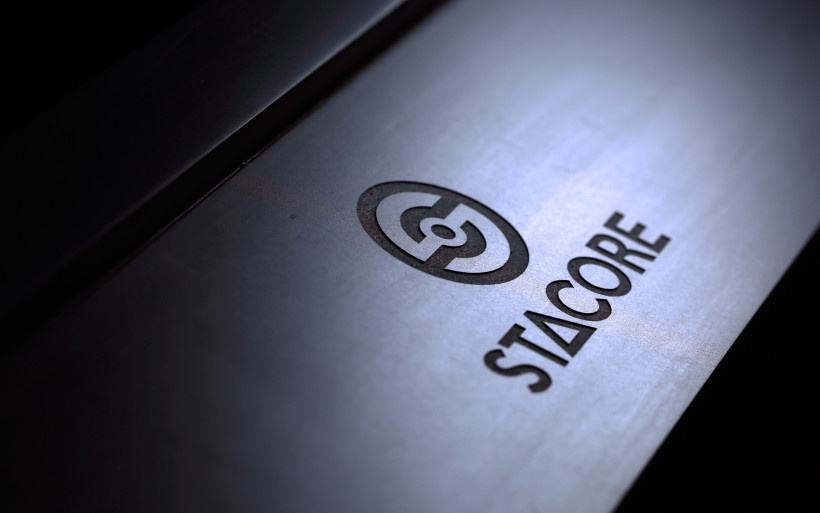 Stacore Advanced is a passive pneumatic platform designed to tame vibrations in wide-bandwidth spectrum. It measures (LxWxH) 80x480x140mm, weighs spine breaking 94 kilograms in total and can handle loads up to 65 kilograms. No wonder the cargo was very difficult to carry, though in order to be efficient it has to be this heavy and there’s no other way around it. Jarek explained that Newton’s Third Law related mass damping is one of key parts in his grand master plan. I was also told that solutions similar to his design yet lighter fall short above 200 Hz, whereas his goes far higher, up to several kHz. Not because of heavy weight alone, though.
Stacore Advanced is a passive pneumatic platform designed to tame vibrations in wide-bandwidth spectrum. It measures (LxWxH) 80x480x140mm, weighs spine breaking 94 kilograms in total and can handle loads up to 65 kilograms. No wonder the cargo was very difficult to carry, though in order to be efficient it has to be this heavy and there’s no other way around it. Jarek explained that Newton’s Third Law related mass damping is one of key parts in his grand master plan. I was also told that solutions similar to his design yet lighter fall short above 200 Hz, whereas his goes far higher, up to several kHz. Not because of heavy weight alone, though.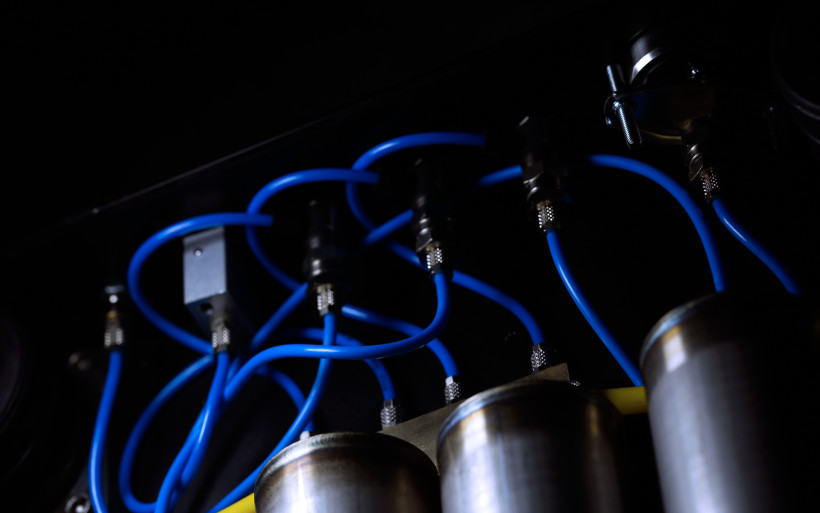 The Polish team wasn’t after laboratory equipment reworked to do the audio job but a multi-stage affair built from scratch and Stacore Advanced is the outcome. High mass, air suspension and roller bearings all work together to damp vibrations and decouple hardware put on it. Here air is crucial as the platform will lift once its inner chambers are filled with it. Quite low and a bit deeper and wider in comparison to a regular audio machine, Stacore Advanced looks very modest though appealing. The whole body almost entirely made out of Italian amorphous slate explains its weight. Jarek and Bogdan cherry-picked this fragile stone because of its damping properties and the latter individual has necessary tools and know-how to handle it properly. It’s also important to know that slate the Stacore team exploits is a CLD (constrained-layer damping) sandwich; between two sheets of slate there’s a viscoelastic ingredient.
The Polish team wasn’t after laboratory equipment reworked to do the audio job but a multi-stage affair built from scratch and Stacore Advanced is the outcome. High mass, air suspension and roller bearings all work together to damp vibrations and decouple hardware put on it. Here air is crucial as the platform will lift once its inner chambers are filled with it. Quite low and a bit deeper and wider in comparison to a regular audio machine, Stacore Advanced looks very modest though appealing. The whole body almost entirely made out of Italian amorphous slate explains its weight. Jarek and Bogdan cherry-picked this fragile stone because of its damping properties and the latter individual has necessary tools and know-how to handle it properly. It’s also important to know that slate the Stacore team exploits is a CLD (constrained-layer damping) sandwich; between two sheets of slate there’s a viscoelastic ingredient.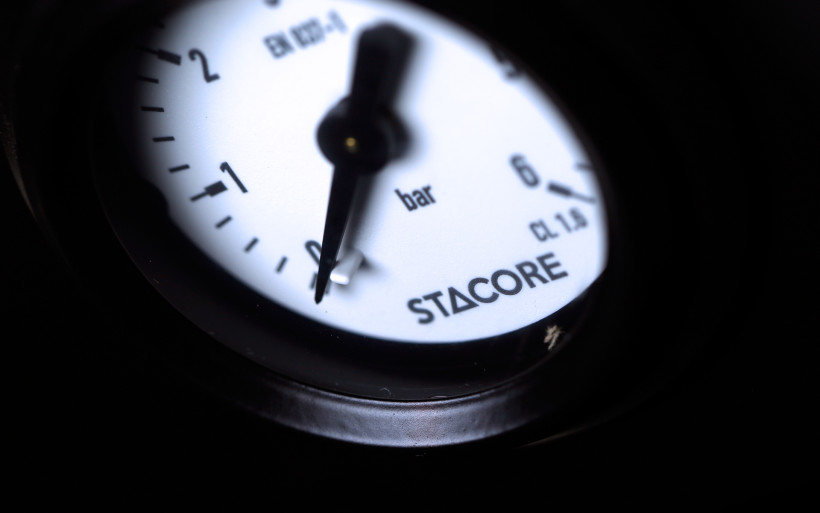 Stacore Advanced looks like a low box with its underbelly opened up to showcase its innards. The company’s logos are engraved on the front and rear, whereas the main valve, air pressure release button, three knobs and a small manometer are to be found on the right side. That’s it, no other additions or ornaments anywhere in sight but a very clean, neatly executed slate job nonetheless. As a very much industrial alike and utilitarian yet pricey tool, it’s not an item which would inject some additional glamour into one’s listening room, but it looks safe thus will fit to any decor. Past closer inspection the conclusion was that this review’s hero is finely crafted and looks like an expensive audio hardware.
Stacore Advanced looks like a low box with its underbelly opened up to showcase its innards. The company’s logos are engraved on the front and rear, whereas the main valve, air pressure release button, three knobs and a small manometer are to be found on the right side. That’s it, no other additions or ornaments anywhere in sight but a very clean, neatly executed slate job nonetheless. As a very much industrial alike and utilitarian yet pricey tool, it’s not an item which would inject some additional glamour into one’s listening room, but it looks safe thus will fit to any decor. Past closer inspection the conclusion was that this review’s hero is finely crafted and looks like an expensive audio hardware.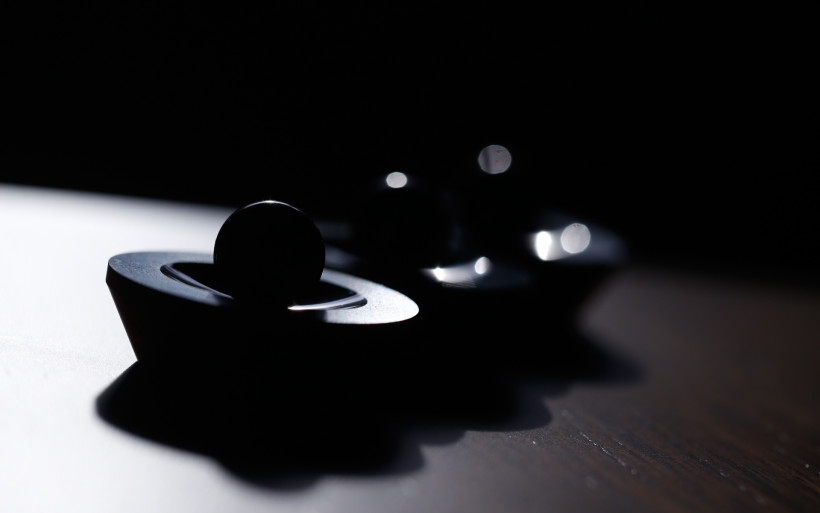 For a good reason Stacore Advanced arrived with a regular electric pump, the very same used to fix tires in a car or a bike. Nothing fancier is needed and everything capable of up to six bars air pressure will do the job just fine. The platform sports an universal intake valve to connect a compressor and a button a bit further to the right releases all air. Three knobs next in line are assigned to air suspension lifts strategically placed in each corner. If one thinks that math doesn’t add up here, it does and is more associated with virtual suspension points than mechanical parts visible. All knobs are connected to the manometer and each has its own reading when switched. That’s how one knows whether it’s time to let some air in or out. Once in a while it has to be done, though I was told that in several months long intervals.
For a good reason Stacore Advanced arrived with a regular electric pump, the very same used to fix tires in a car or a bike. Nothing fancier is needed and everything capable of up to six bars air pressure will do the job just fine. The platform sports an universal intake valve to connect a compressor and a button a bit further to the right releases all air. Three knobs next in line are assigned to air suspension lifts strategically placed in each corner. If one thinks that math doesn’t add up here, it does and is more associated with virtual suspension points than mechanical parts visible. All knobs are connected to the manometer and each has its own reading when switched. That’s how one knows whether it’s time to let some air in or out. Once in a while it has to be done, though I was told that in several months long intervals.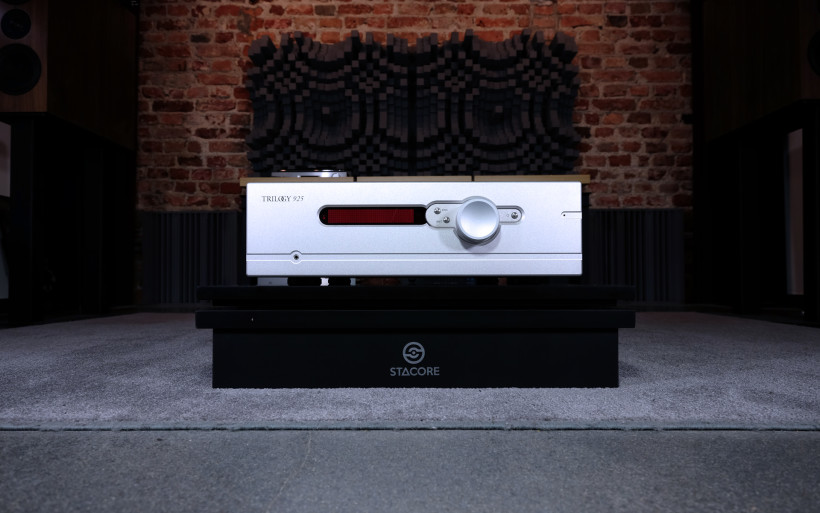 Stacore Advanced is the priciest (€5’995) model the Polish duo has to offer. In comparison to Basic (€3’995) and Basic+ (€4’595) versions, its base comes with a shelf that goes on top and ball bearing mechanism in-between, which provides additional level of isolation and widens effective bandwidth. This upgrade consists of three stainless steel races and the same number of balls based on Tungsten Carbide, all in-house made. Prior to settling in, the plate sways literally endlessly. In order to use Stacore Advanced, no rocket science is needed. It has to sit on a flat surface and any remaining air needs to be let out. Once this is done, a given audio hardware ought to be placed on the platform’s top shelf. Then valves released, air injected and all three shut past this activity is all it takes. Jacek suggested to pump his creation up to a point where a 3 to 5mm gap in-between this product and my floor was visible. This exactly was done as he also instructed that no more or less is usually needed. When everything was set up, 3 bars of pressure were visible on Stacore Advanced’s manometer.
Stacore Advanced is the priciest (€5’995) model the Polish duo has to offer. In comparison to Basic (€3’995) and Basic+ (€4’595) versions, its base comes with a shelf that goes on top and ball bearing mechanism in-between, which provides additional level of isolation and widens effective bandwidth. This upgrade consists of three stainless steel races and the same number of balls based on Tungsten Carbide, all in-house made. Prior to settling in, the plate sways literally endlessly. In order to use Stacore Advanced, no rocket science is needed. It has to sit on a flat surface and any remaining air needs to be let out. Once this is done, a given audio hardware ought to be placed on the platform’s top shelf. Then valves released, air injected and all three shut past this activity is all it takes. Jacek suggested to pump his creation up to a point where a 3 to 5mm gap in-between this product and my floor was visible. This exactly was done as he also instructed that no more or less is usually needed. When everything was set up, 3 bars of pressure were visible on Stacore Advanced’s manometer. If one wonders how this device works, it’s actually very simple on the surface. All elements found on its control panel connect to a number of tubes married to several compression chambers which then feed several lifts. Air that goes in is then compressed and passed on to those air suspension bladders which elevate the platform along with its cargo. That’s it. This machine might seem to be easy to replicate, yet past several talks with Jarek and acknowledging that he knows a lot about physics and audio, there’s far more to his and Bogdan’s Advanced model than meets the eye, at least that was my impression.
If one wonders how this device works, it’s actually very simple on the surface. All elements found on its control panel connect to a number of tubes married to several compression chambers which then feed several lifts. Air that goes in is then compressed and passed on to those air suspension bladders which elevate the platform along with its cargo. That’s it. This machine might seem to be easy to replicate, yet past several talks with Jarek and acknowledging that he knows a lot about physics and audio, there’s far more to his and Bogdan’s Advanced model than meets the eye, at least that was my impression.
Sound
In order to review Stacore Advanced, Sveda Audio Blipo active monitors were used, whereas LampizatOr Golden Gate (Psvane WE-101D + KR Audio 5U4G Ltd. Ed.) handled the D/A conversion task (…and volume control when needed) and was fed via Asus UX305LA. Later on Trilogy 925 and Boenicke W8 were on duty as well. The main opponent of this review’s hero was my Wood Block Rack by Polish Franc Audio Accessories manufacture and at some point Lecontoure’s K-Rak entered the stage as well.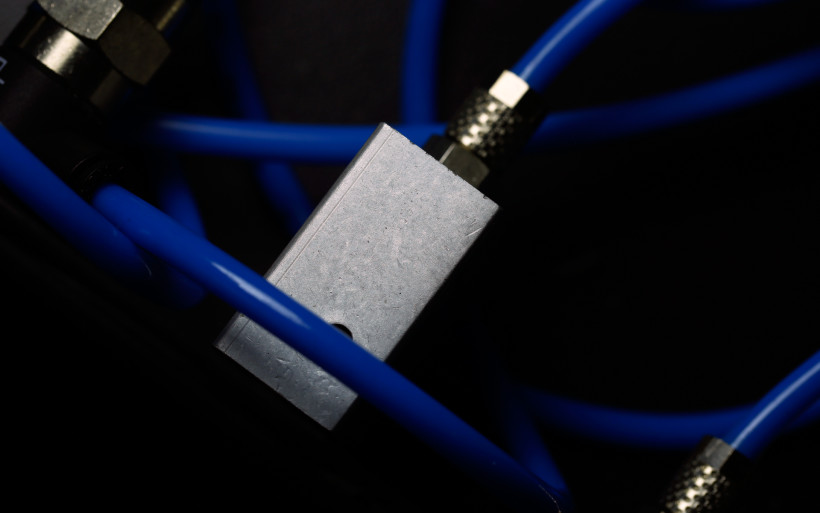 The first order of business was placement. A suitable space for Stacore Advanced had to be prepared and it quickly turned out that my reference rack was off limits. The former product’s weight was the very reason. Top shelves in Paweł Skulimowski’s product are able to handle loads up to around 50 kilograms at most and the wider, thicker and longer one beneath didn’t have enough room to guest the Polish platform and either of my electronics on top of it. Hence this review’s main star had to sit on the concrete floor and Jarek considered this scenario as perfectly fine.
The first order of business was placement. A suitable space for Stacore Advanced had to be prepared and it quickly turned out that my reference rack was off limits. The former product’s weight was the very reason. Top shelves in Paweł Skulimowski’s product are able to handle loads up to around 50 kilograms at most and the wider, thicker and longer one beneath didn’t have enough room to guest the Polish platform and either of my electronics on top of it. Hence this review’s main star had to sit on the concrete floor and Jarek considered this scenario as perfectly fine.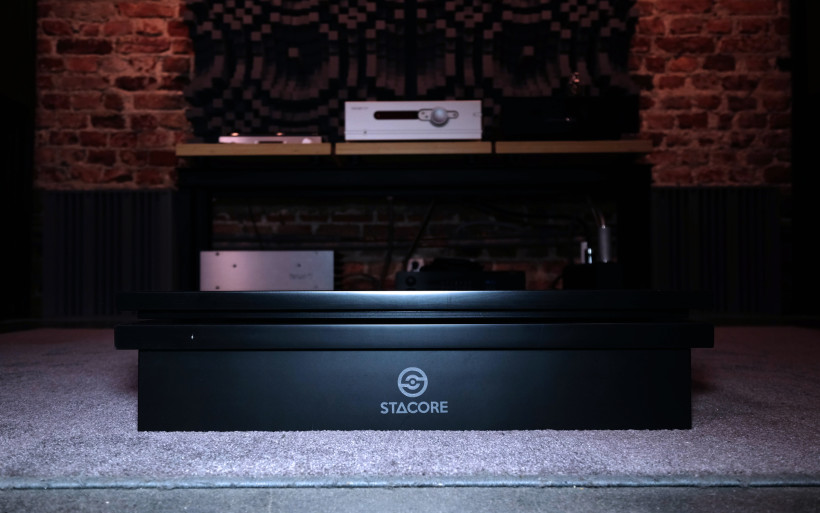 The initial assumption was that equipment with moving parts inside – a CD player or a turntable – should benefit from Stacore Advanced the most. Neither is a part of my setup, hence I had to rely solely on the usual suspects; the Trilogy 925 integrated and the Golden Gate DAC. The later machine seemed to be more promising, hence was the first one used during evaluation. Loaded with a number of sensitive DHTs, it’s susceptible to various tweaks. Łukasz Fikus told me in the past that to make these valves not as prone to microphonics was one of the most challenging tasks he struggled with. That’s why Golden Gate loaded with roller block based decoupling feet is the standard option, whereas Stacore Advanced provides this type of decoupling and ups the ante via extensive mass plus pressurized suspension.
The initial assumption was that equipment with moving parts inside – a CD player or a turntable – should benefit from Stacore Advanced the most. Neither is a part of my setup, hence I had to rely solely on the usual suspects; the Trilogy 925 integrated and the Golden Gate DAC. The later machine seemed to be more promising, hence was the first one used during evaluation. Loaded with a number of sensitive DHTs, it’s susceptible to various tweaks. Łukasz Fikus told me in the past that to make these valves not as prone to microphonics was one of the most challenging tasks he struggled with. That’s why Golden Gate loaded with roller block based decoupling feet is the standard option, whereas Stacore Advanced provides this type of decoupling and ups the ante via extensive mass plus pressurized suspension.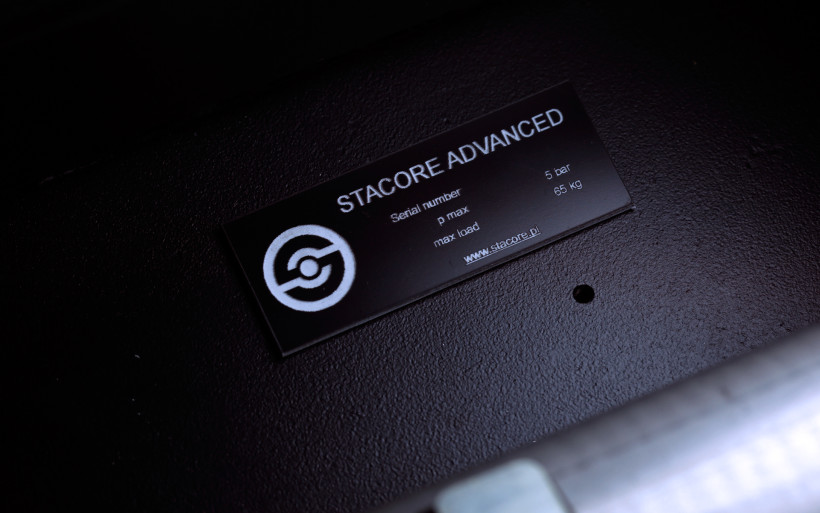 At first, LampizatOr Golden Gate DAC was placed on Franc Audio Accessories Wood Block Rack 1+3. This 80 kilograms heavy contraption loaded with the same company’s ceramic balls based Ceramic Disc Fat Feet (4) and Tablets (12) serves the journalistic purpose very well. In comparison to a regular concrete floor it introduces audible changes and – since it’s able to accommodate six devices in total – is very convenient to use. From this perspective, Stacore Advanced designed to handle only one machine is of course less cost and handling effective, yet tables turn if the sound quality talk is on. The edge Stacore product held over my reference rack was there.
At first, LampizatOr Golden Gate DAC was placed on Franc Audio Accessories Wood Block Rack 1+3. This 80 kilograms heavy contraption loaded with the same company’s ceramic balls based Ceramic Disc Fat Feet (4) and Tablets (12) serves the journalistic purpose very well. In comparison to a regular concrete floor it introduces audible changes and – since it’s able to accommodate six devices in total – is very convenient to use. From this perspective, Stacore Advanced designed to handle only one machine is of course less cost and handling effective, yet tables turn if the sound quality talk is on. The edge Stacore product held over my reference rack was there.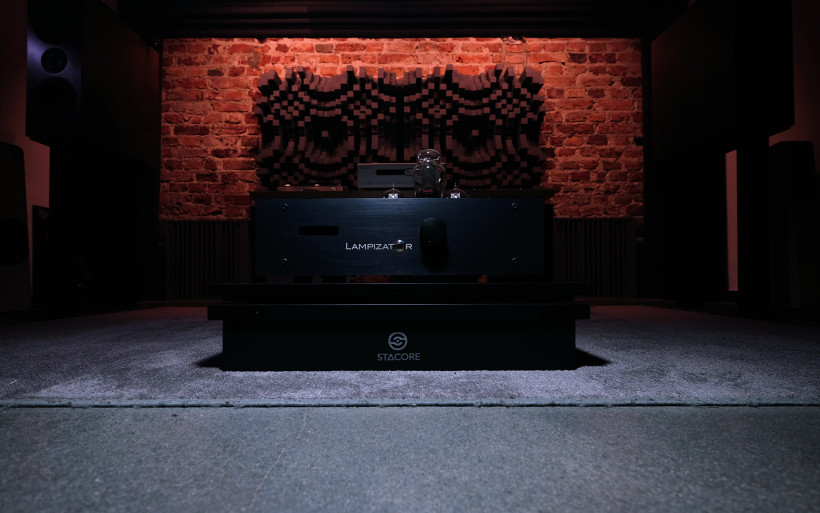 In this review I wrote that Paweł Skulimowski’s rack bested Lecontoure’s K-Rak audibly. Once all my hardware was put on the former, the sound got a bit slimmer and more open, whereas the latter product netted beefier and fuzzier outcome. To follow in that vein, Stacore Advanced remained somewhere in the middle. It elevated body weight a bit in comparison to Paweł’s top of the line solution, yet was more fit than K-Rak. After several back-and-forths between all three, Stacore Advanced seemed to be the most balanced one and several days later it became obvious that it provided the most even tonal balance. The subjective notion was that this product did the most by actually not doing anything other than compensation job. It didn’t render the outcome as beefier or shinier but even instead and that’s why was considered as the winner.
In this review I wrote that Paweł Skulimowski’s rack bested Lecontoure’s K-Rak audibly. Once all my hardware was put on the former, the sound got a bit slimmer and more open, whereas the latter product netted beefier and fuzzier outcome. To follow in that vein, Stacore Advanced remained somewhere in the middle. It elevated body weight a bit in comparison to Paweł’s top of the line solution, yet was more fit than K-Rak. After several back-and-forths between all three, Stacore Advanced seemed to be the most balanced one and several days later it became obvious that it provided the most even tonal balance. The subjective notion was that this product did the most by actually not doing anything other than compensation job. It didn’t render the outcome as beefier or shinier but even instead and that’s why was considered as the winner.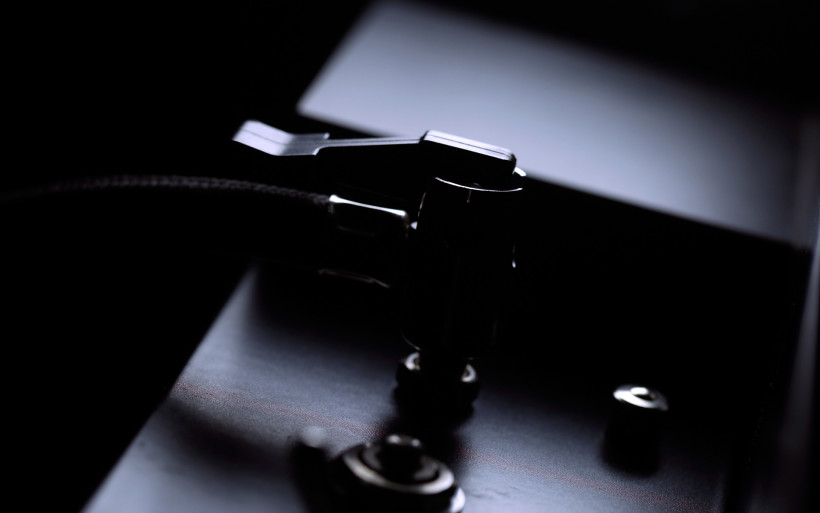 With K-Rak and Wood Block Rack I could target and counteract tonal balance related issues, which I’ve been exploiting for some time now. The latter product works in a synergistic fashion with my gutsy hardware, whereas Stacore Advanced played a different game. Instead of masking or reworking anything, it showcased things as they were and thus was the most veracious. This indicated the next level play above my both current and previous reference racks. It was about something else, not meta related but beyond. The more I investigated the more obvious it became what Stacore Advanced did. In short, this heavy machine showcased what my decks really are instead of altering their behaviour. When this platform was on, I got more from both; my DAC and the integrated amp. The sensation was comparable to the same road trip as per usual, yet in a more comfortable car.
With K-Rak and Wood Block Rack I could target and counteract tonal balance related issues, which I’ve been exploiting for some time now. The latter product works in a synergistic fashion with my gutsy hardware, whereas Stacore Advanced played a different game. Instead of masking or reworking anything, it showcased things as they were and thus was the most veracious. This indicated the next level play above my both current and previous reference racks. It was about something else, not meta related but beyond. The more I investigated the more obvious it became what Stacore Advanced did. In short, this heavy machine showcased what my decks really are instead of altering their behaviour. When this platform was on, I got more from both; my DAC and the integrated amp. The sensation was comparable to the same road trip as per usual, yet in a more comfortable car.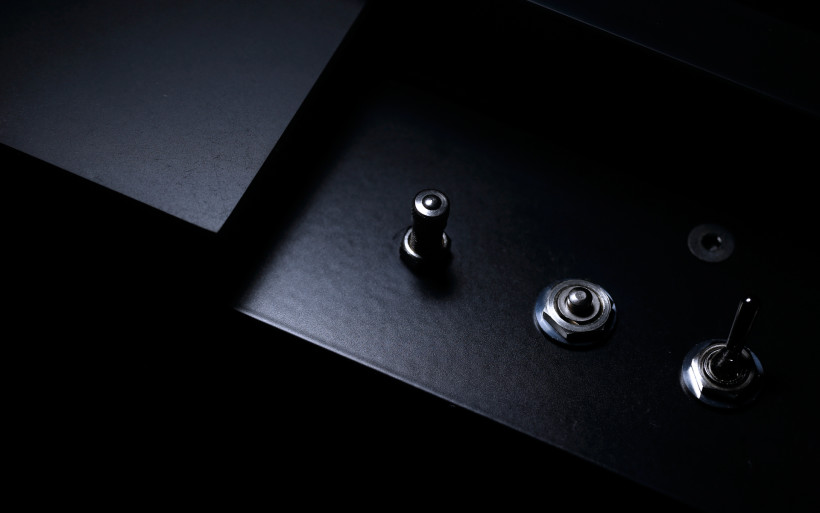 Stacore Advanced introduced changes similar to recently reviewed GigaWatt PC-2 EVO+ power conditioner, namely the quite extensive sorting service. When this air filled platform was on the job, the usual suspects were addressed; background grain, smoothness, informational tissue, on-stage air amount, expansiveness, downstairs control etc. The improvement was on these counts exactly minus the morphing act, any obvious meta change wasn’t a part of the show. My Golden Gate sounded as gutsy as per usual and the same story was with i.e. its downstairs presence. It short, it didn’t became anything it wasn’t in the first place. But the most beneficial difference was in this machine’s expanded boundaries.
Stacore Advanced introduced changes similar to recently reviewed GigaWatt PC-2 EVO+ power conditioner, namely the quite extensive sorting service. When this air filled platform was on the job, the usual suspects were addressed; background grain, smoothness, informational tissue, on-stage air amount, expansiveness, downstairs control etc. The improvement was on these counts exactly minus the morphing act, any obvious meta change wasn’t a part of the show. My Golden Gate sounded as gutsy as per usual and the same story was with i.e. its downstairs presence. It short, it didn’t became anything it wasn’t in the first place. But the most beneficial difference was in this machine’s expanded boundaries.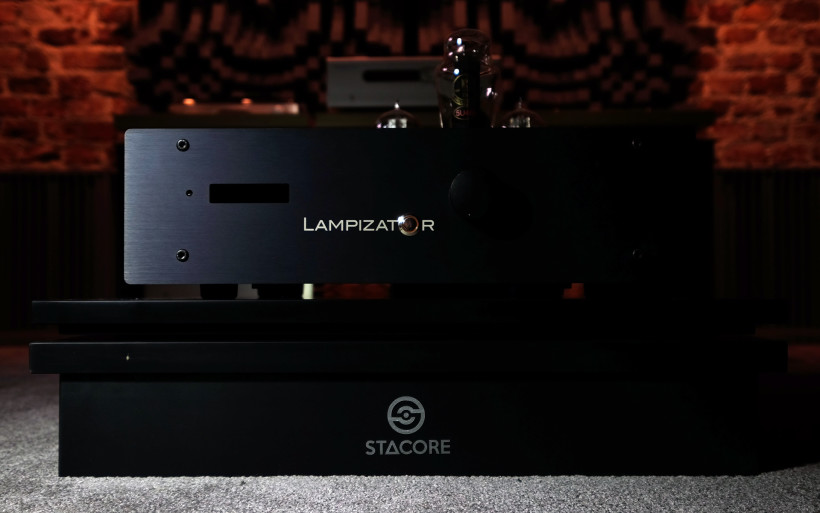 In short, I got more mileage out of my Golden Gate, yet its fuel thirsty economy somehow remained intact. To translate this into properly audiophile lingo, this machine sang more openly than thus far. Because of additional air injection and a bit bigger more present soundstage, less fuzzy and more focused image happened in the process. Instruments onstage were easier to distinguish and more here, less there. When singled out, each of these tweaks is mild at best, not a night and day difference talk is on here. But when all are combined, the effect is far more potent, audible and with no drawbacks. A passive platform capable of pulling off the same stunts as a proper power conditioner? Now that might be quite revealing news to many of our kind.
In short, I got more mileage out of my Golden Gate, yet its fuel thirsty economy somehow remained intact. To translate this into properly audiophile lingo, this machine sang more openly than thus far. Because of additional air injection and a bit bigger more present soundstage, less fuzzy and more focused image happened in the process. Instruments onstage were easier to distinguish and more here, less there. When singled out, each of these tweaks is mild at best, not a night and day difference talk is on here. But when all are combined, the effect is far more potent, audible and with no drawbacks. A passive platform capable of pulling off the same stunts as a proper power conditioner? Now that might be quite revealing news to many of our kind.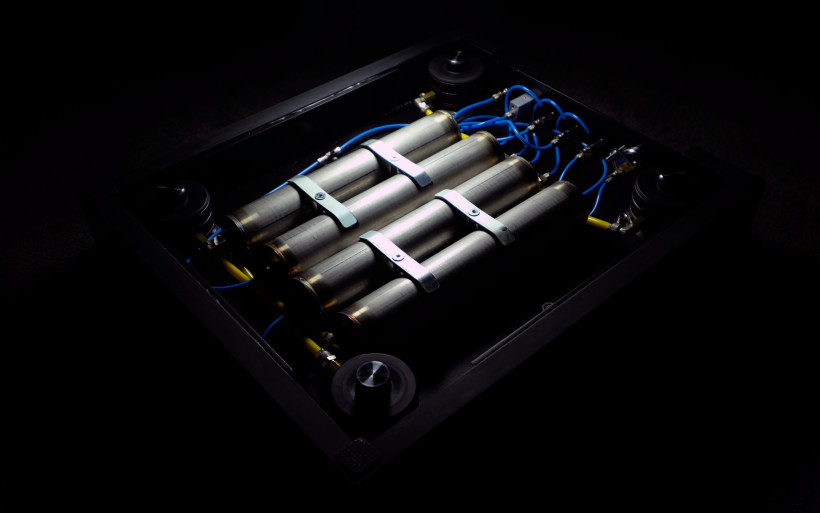 With its roller block support out and stock rubber feet in, LampizatOr Golden Gate sounds more brittle and edgier. Once I acknowledged that this is the case, I never used the latter option again. Then Wood Block Rack provided another level of decoupling and damping and the sound pushed even further in the same direction to become audibly better. With Stacore Advanced, a very similar improvement happened, yet the overall sensation was that my reference DAC didn’t change at all. It flaunted with its most prominent features more pronouncedly and was in general more open, but remained at its core. And that’s something neither Wood Block Rack nor Lecontoure K-Rak were capable of. Just to ease my own curiosity, at some point my reference source was placed on concrete floor directly. Not backed by Polish air platform’s input and with LampizatOr’s roller blocks removed as well, the sound got far worse on many counts and the overall experience – although not traumatizing yet – was far less enjoyable. The takeaway message was clear. This DAC benefits from anti-vibration tweaks immensely. Grain increased, energy weakened, smoothness truncated and fuzzier less focused imaging were the main culprits. Ouch.
With its roller block support out and stock rubber feet in, LampizatOr Golden Gate sounds more brittle and edgier. Once I acknowledged that this is the case, I never used the latter option again. Then Wood Block Rack provided another level of decoupling and damping and the sound pushed even further in the same direction to become audibly better. With Stacore Advanced, a very similar improvement happened, yet the overall sensation was that my reference DAC didn’t change at all. It flaunted with its most prominent features more pronouncedly and was in general more open, but remained at its core. And that’s something neither Wood Block Rack nor Lecontoure K-Rak were capable of. Just to ease my own curiosity, at some point my reference source was placed on concrete floor directly. Not backed by Polish air platform’s input and with LampizatOr’s roller blocks removed as well, the sound got far worse on many counts and the overall experience – although not traumatizing yet – was far less enjoyable. The takeaway message was clear. This DAC benefits from anti-vibration tweaks immensely. Grain increased, energy weakened, smoothness truncated and fuzzier less focused imaging were the main culprits. Ouch. Once the DAC matter was sorted, this machine swapped places with my reference integrated. The same beneficial job was done, yet the overall effect wasn’t as potent. Trilogy 925 seemed to be less susceptible to Polish product’s input, though one aspect improved audibly. With this machine, Boenicke W8 oftentimes gets a bit wobbly downstairs and that’s what Stacore Advanced tamed in most cases. It wasn’t able to negate boom completely, yet did a nice job in reducing its effect nonetheless. The sound in general improved as well; a bit tighter, served more focused and clearer it became better indeed. Though let me stress again that this time around the outcome was less obvious in comparison to what happened with Golden Gate.
Once the DAC matter was sorted, this machine swapped places with my reference integrated. The same beneficial job was done, yet the overall effect wasn’t as potent. Trilogy 925 seemed to be less susceptible to Polish product’s input, though one aspect improved audibly. With this machine, Boenicke W8 oftentimes gets a bit wobbly downstairs and that’s what Stacore Advanced tamed in most cases. It wasn’t able to negate boom completely, yet did a nice job in reducing its effect nonetheless. The sound in general improved as well; a bit tighter, served more focused and clearer it became better indeed. Though let me stress again that this time around the outcome was less obvious in comparison to what happened with Golden Gate.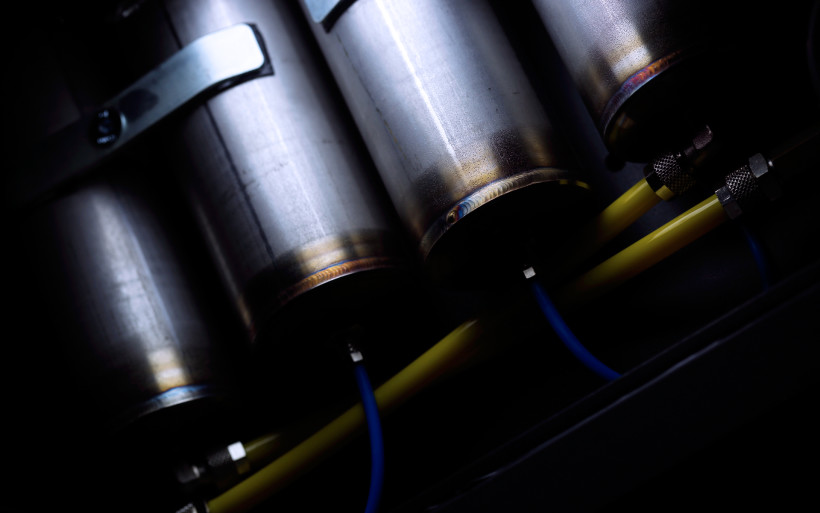 Stacore Advanced turned out to be beneficial for both my daily drivers. Their potential amplified yet not changed counts as one of the major upshots undoubtedly. Usually in order to gain something, at least a small sacrifice has to be made somewhere, yet with Stacore Advanced this was not the case, not in the slightest. Sound wise this review’s hero simply elevated the experience audibly with no trade-offs, it showcased more clearly what my hardware is capable of, how far it can go. To invoke the car analogy again, Stacore Advanced not only delivered me on time to the very same destination place in comfier, smoother and more fuel happy ride than usually, but the view outside was also far more clear and vivid, hence nicer. No wonder, instead of a regular five-door hatchback I drove in its cabrio sibling with no roof above me all the time.
Stacore Advanced turned out to be beneficial for both my daily drivers. Their potential amplified yet not changed counts as one of the major upshots undoubtedly. Usually in order to gain something, at least a small sacrifice has to be made somewhere, yet with Stacore Advanced this was not the case, not in the slightest. Sound wise this review’s hero simply elevated the experience audibly with no trade-offs, it showcased more clearly what my hardware is capable of, how far it can go. To invoke the car analogy again, Stacore Advanced not only delivered me on time to the very same destination place in comfier, smoother and more fuel happy ride than usually, but the view outside was also far more clear and vivid, hence nicer. No wonder, instead of a regular five-door hatchback I drove in its cabrio sibling with no roof above me all the time.
Summary
Stacore Advanced addresses a non-mainstream subject, is costly and was designed to work with one component at the same time exclusively, hence it goes rather without saying that many enthusiasts, even those very much into the audio hobby, will render this review’s hero as excessive/unpractical/not reasonable. On paper, all odds might seem to be stacked against it, whereas practice says otherwise.
I was recently told that Jarek Korbicz and Bogdan Stasiak have their hands full. Past several weeks spent with their pneumatic platform’s highest version available and grasping what it does, this comes as no surprise to me at all. The early assumption was that hardware with moving parts inside would benefit from Stacore’s Advanced the most, yet this platform upped the ante in my setup free from these not mildly but unexpectedly audibly nonetheless. Go figure.
Very nicely made, backed by serious engineering and priced accordingly, Stacore Advanced simply works as intended and its effectiveness will surely make many naysayers surprised to say the least. As an understandable obstacle, this product’s spine shattering mass has to be taken into serious account, yet the effect wouldn’t have been this potent without it. This time around this is what it takes, hence it’s for the best to arrange a helping pair of hands or two prior delivery. Just sayin’
As a very specialist product, Stacore Advanced will please financially ready individuals left with no room to maneuver as far as their major audio hardware goes, yet eager to squeeze every ounce of goodness from it. Hence if you’re an enthusiast very much into the no-compromise extreme game, past any prejudice towards high calibre tweaks and willing to push your setup as far as possible, by all means feel free to give this review’s hero a chance and prepare yourself for a very pleasant surprise. ‘Till next time!
Associated equipment:
- Amplifiers: Trilogy 925
- Sources: Lampizator Golden Gate (Psvane WE101D-L + KR Audio 5U4G Ltd. Ed.), AMR DP-777SE
- Speakers: Boenicke Audio W8
- Transports: Asus UX305LA
- Speaker cable: Forza AudioWorks Noir Concept, Audiomica Laboratory Celes Excellence
- Interconnects: Forza AudioWorks Noir, Audiomica Laboratory Erys Excellence
- Power supply: Gigawatt PF-2 + Gigawatt LC-2 MK2 + Forza AudioWorks Noir Concept/Audiomica Laboratory Ness Excellence
- Rack: Franc Audio Accesories Wood Block Rack
- Music: NativeDSD
Retail prices of reviewed components in EU (incl. VAT):
- Stacore Basic: €3’995
- Stacore Basic+: €4’595
- Stacore Advanced: €5’995
Manufacturer: Stacore


